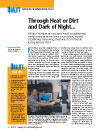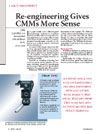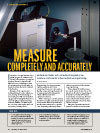
Once considered a luxury for ensuring quality control, coordinate measuring machines (CMMs) are now a staple in both large manufacturing plants and small job shops. This monthQualitytakes a look back at technology that was developed in the early 1960s.
Through Heat or Dirt and Dark of Night ..., January 2002
Coordinate measuring machines (CMMs) have left behind the shackles of the metrology lab and found a home in the shop, near production, where they can best be used to conduct fast and accurate 3-D measurements of parts as they are made.These companies are not alone. Manufacturers of a wide variety of products have successfully overcome the difficulties of inspecting parts near production areas. The CMMs can be found on transfer lines, inside manufacturing workcells and as part of elaborate multitechnology turnkey systems. In some cases, the CMMs are off-line but nearby, so that parts can be quickly conveyed or hauled by robot or forklift from machine tools to CMMs for inspection. These sophisticated measurement, test and inspection tools are being used for first article inspection, 100% inspection, and random inspection in pre-process, in process and post process placement-all with the idea of discovering nonconforming parts before they are shipped to customers or to the next production process.
And it is not just large automobile or aerospace companies that are using CMMs in this way. One of the strengths of today’s CMM offerings is that they are affordable for smaller companies while still being factory friendly enough to allow them to be used without having to construct an expensive metrology lab.
CMMs were introduced in the early 1960s, but not until the 1990s did CMMs really start to come out from the clean, temperature-stable environment of the laboratory. As part measurements increasingly moved from the lab to the plant floor, CMM suppliers realized that their products must be tough enough to take their places near the machine tools and still provide the kind of accuracy, repeatability and data-analysis capability needed.
That means that the CMMs must be shop-hardened with temperature-resistant materials, antivibration systems, protected guideways-such as bearing and scale covers-and scale systems that have low coefficients of thermal expansion (CTE).
Variations in temperature are generally considered to be the biggest problem to be overcome. Temperature affects the base material at the microscopic level and the cumulative effects cause structural changes in both the CMM and the parts being measured. Objects are at their correct size only at 20 C or 68 F and any differences in temperature can affect measurements. The extent of the change depends on the material that the CMM is made of, as well as the material that the part to be measured is made from.

Re-engineering Gives CMMs More Sense, May 2003
In a perfect world, or in a fully integrated manufacturing environment, metrology systems would be able to measure all necessary parameters in one pass, without error, and feed back results seamlessly to computer-integrated manufacturing networks, in the formats most useful for machine control and process management.One aspect of that utopian vision is the ability of an automated instrument to measure a part, or family of parts, with one setup per part. This vision is what has been driving increased use of coordinate measurement machines (CMMs) and now, increasingly, toward the use of multisensor CMMs.
Demands on metrology technology have never been greater, and the migration of measuring technology toward the manufacturing process means a higher level of functionality is required on the measuring side of this equation.
Multisensor CMMs can be the common denominator in this equation. The CMM can combine various sensors including a contact stylus and a noncontact laser that are driven through 3-D space to accumulate data points and vision sensors that are able to take measurements of all types. The CMM also has the structural ability to work closer to the actual manufacturing process.

CMMs Create Flexible Feedback, March 2005
The use of coordinate measuring machines (CMMs) in traditional quality control rooms, isolated from the production floor, often proves unsuitable for effective and timely feedback on the manufacturing process.The time required to collect parts from the line, take them to the quality control room, thermally stabilize them and run the inspection cycle generally is longer than the manufacturing cycle itself. As a result, the process may produce a large number of non-conforming parts before corrections can be made.
The use of a flexible measuring system such as a CMM on the shop floor allows dimensional inspection strategies to evolve from the traditional “adjust by failure” method to the more effective “mastered adjust” approach. This approach focuses on the real-time monitoring of process drifts to prevent the production of defective parts and provide essential information to optimize the process.
For more than 25 years, CMMs have complemented traditional dedicated gages or have replaced them. The coordinate measuring operation can be performed quickly when compared with surface plate techniques or fixed gages, meaning that measurement results can be used to cost-effectively refine manufacturing process applications and analyze process trends.
To effectively meet the application requirements of dimensional control on the shop floor, CMMs must contain the following:
High Inspection throughput.
High level of accuracy to ensure compliance of manufactured parts to design tolerances.
Ease of use for operators without specific metrology knowledge.
Ease of load and unload operations and, when needed, integration with the manufacturing flow via hardware and software.
Capability to generate measuring programs off-line without interrupting the normal CMM operation.
Suitable machine protection from the environment and operator protection for personal safety.
Optimize Coordinate Metrology on the Shop Floor, April 2006
The primary reason for installing and operating coordinate measuring machines (CMMs) on the shop floor is to keep process quality under control, preventing the production of defective parts.Time is a critical factor. To reduce measurement time to a minimum, only the most critical features should be inspected in a typical process control operation. Nearly all CMMs feature good dynamics and are able to perform positional moves and pick up points very quickly. As a result, measuring programs generally require a short execution time.
The measurement cycle itself represents only a small part of the time required to execute the “floor-to-floor cycle”-from collection and loading of parts on the CMM to their removal once inspection is completed. It’s not uncommon to find situations in which the loading/unloading operations take considerably longer than the measurement cycle.
Some CMM manufacturers provide turnkey measuring systems that optimize the floor-to-floor cycle at various automation and integration levels. These measuring systems normally include the CMM, loading/unloading systems, fixtures and software. They are specifically designed and built to meet the technical requirements of various applications depending on the type of parts to be measured, part weight, sampling rate, specific production, and the economic requirements of small, medium and large firms.

Measure Completely and Accurately, December 2006
Inspection is a critical element of any quality program. In addition to the dimensional inspection of workpiece functional elements-typically with tight tolerances-evaluating products increasingly involves the inspection of free-form surfaces that are not relevant to the function.Examples of such requirements include plastic parts such as cell phone cases, housings for electrical plugs or automotive parts. With current technology, geometries with tight tolerances are measured with coordinate measuring machines (CMMs). Complete acquisition of a component requires the use of many rotary and tilt positions. Programming of such measurements requires experience and is time-consuming. Some sensors also require that the component be pretreated, such as being sprayed with white paint to obtain sufficient contrast for optical measurement.
What is missing is a measuring device that allows complete, accurate and rapid measurement of the component’s functionally relevant dimensions, regardless of its complexity, without preparation of the component and without extensive programming.
Today, a typical first-article inspection report consists of up to 500 or 600 dimensions. In order to inspect the part for function, normally 10% of these measurements are necessary. The rest is used mostly for later reference and, in general, to check for the correct shapes of radii and slopes.
Taking into account the state of the projects on which these measurements have to be made, saving time provides potential for improvement.
A new system takes advantage of the X-ray computed tomography principle in order to perform measurements during the first out-of-tool (FOT) procedure, as well as for the full first-article inspection.
The idea behind this approach is to obtain a 3-D point cloud of the entire part with all surfaces and inner geometries, including voids and bubbles. The point cloud can be evaluated by software for all types of applications-inspection, FOT testing and first- article inspection.

Portable CMMs Go to Source of Inspection, November 2010
For the machine shop that supplies the aerospace industry, portable coordinate measuring machine (PCMM) and model based definition (MBD) are everyday terms that are integral parts of its daily inspection routines.In the effort to drive quality and control processes, aerospace OEMs have altered the inspection methodology and the tools of their entire supply chain. Many of these suppliers are small- or mid-sized machine shops that have invested in inspection hardware, software and processes to satisfy strict quality standards. With the success of these supply chain efforts, portable CMMs and the model based definition inspection technology are expected to spread to all industrial segments.
Now, it would appear that these new inspection tools and processes would place a big burden on the machine shop while benefitting only the aerospace manufacturer. It is true that this approach to quality control and inspection does demand more than what the usual assortment of hand tools and gages can deliver. It places much more emphasis on CMM-based inspections, which could mean a big investment in quality control. However, the new quality practices actually benefit the machine shop, fabricator or tool maker and it costs a lot less then they might expect.
By deploying PCMMs to the shop floor, these small businesses are realizing gains without staffing up in the quality control department. These companies are performing thorough and accurate measurements quicker than previously possible. They have adopted a convenient and efficient measurement process that covers everything from incoming inspection through final part inspection. And they have gained greater control over their processes.